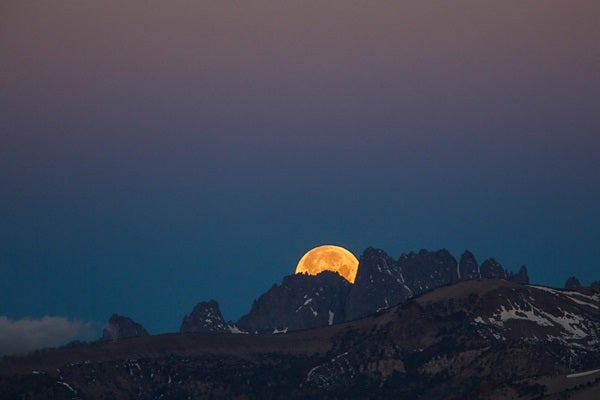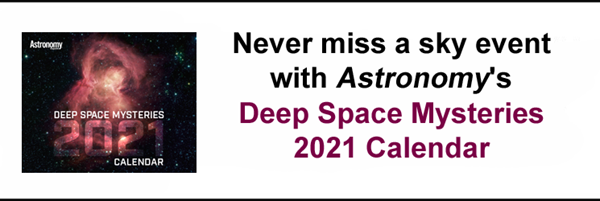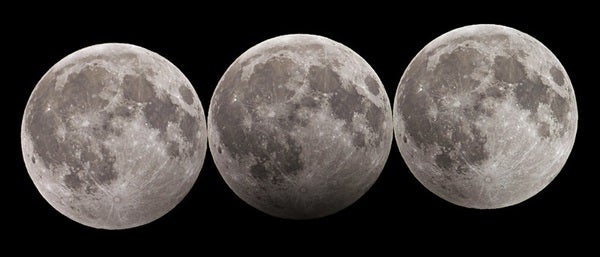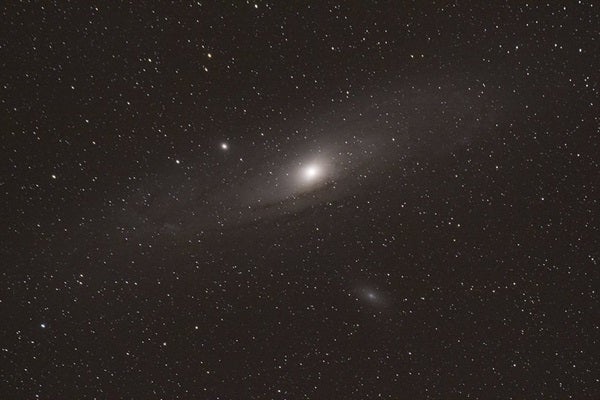Last week, Saturn’s largest moon, Titan, was due north of the planet. Tonight, it is due south. You’ll find Saturn (magnitude 0.6) in the southwest after sunset, alongside blazingly bright Jupiter (magnitude –2.1) in the constellation Sagittarius. Zoom in on the Saturn system with a telescope and you’ll see Titan (magnitude 8) 1′ from the center of the disk. Stretching out to the planet’s east in a line are, from nearest to farthest, Enceladus, Tethys, and Dione. Look at a 90° angle from Dione to find Rhea just 19″ to its north
Sunrise*: 6:59 A.M.
Sunset: 4:36 P.M.
Moonrise: 3:24 P.M.
Moonset: 4:12 A.M.
Moon Phase: Waxing gibbous (94%)
*Times for sunrise, sunset, moonrise, and moonset are given in local time from 40° N 90° W. The Moon’s illumination is given at 12 P.M. local time from the same location.
Saturday, November 28
With a bright Moon in Aries all night, it’s best to focus on brighter targets tonight. Northeast of our satellite is the open cluster M45, also known as the Pleiades. Below them, closer to the horizon at sunset, is the bright star Aldebaran, the reddish eye of Taurus the Bull. The 14th brightest star in the sky, Aldebaran is a type-K giant star with a surface temperature a bit cooler than the Sun. But what it lacks in heat it makes up for in size, stretching out to 44 times our Sun’s diameter. If you plunked it into our solar system in place of the Sun, it would stretch halfway to Mercury’s orbit and cover 20° in the sky (the Sun covers just 0.5°, the same apparent size as the Full Moon).
Wait another two hours or so and most of Orion has cleared the horizon. His brightest stars are Betelgeuse, Rigel, and Bellatrix. Betelgeuse, like Aldebaran, is a cool giant star, while Rigel and Bellatrix are younger and hotter — and therefore bluer. Compare and contrast their colors through binoculars or a telescope to see whether you can tell the difference.
Sunrise: 7:00 A.M.
Sunset: 4:36 P.M.
Moonrise: 3:51 P.M.
Moonset: 5:11 A.M.
Moon Phase: Waxing gibbous (97%)
Neptune has been moving southwest against the background stars of Aquarius for some time now, steadily approaching 4th-magnitude Phi (φ) Aquarii. At 4 A.M. EST today, however, Neptune reaches its stationary point, coming within 44′ of the star. After that, it will begin pulling away again, moving northeast against the celestial background.
Neptune is currently an evening planet, glowing at magnitude 7.9 and spanning just 2″. You should be able to spot it with binoculars or a small telescope as a “flat” blue-gray star near slightly orange-hued Phi.
While you have your observing tools out, Aquarius is currently also home to dwarf planet 1 Ceres, glowing at magnitude 9. Tonight, you’ll find the main belt’s largest object in the southwestern corner of the constellation, 7.5° west of 88 Aquarii. Like Neptune, under high magnification and with good seeing you might notice that Ceres appears slightly flat in appearance. It’s just 0.4″ across, which translates to a diameter of roughly 600 miles (965 km) at its distance.
Sunrise: 7:01 A.M.
Sunset: 4:35 P.M.
Moonrise: 4:21 P.M.
Moonset: 6:11 A.M.
Moon Phase: Waxing gibbous (99.6%)
The Full Moon occurs at 4:30 A.M. EST this morning. November’s Full Moon is traditionally called a Beaver Moon, and this one is particularly special. Today, much of the world will be treated to a penumbral lunar eclipse, when the Moon passes through the penumbra, or outer portion of Earth’s shadow.
At greatest eclipse, about 82 percent of the Moon will be in shadow, although casual observers may have a somewhat difficult time spotting the subtle difference between the eclipsed and non-eclipsed Moon. Because the penumbra is only the outer region of Earth’s shadow, the Moon’s brightness is only slightly dimmed during such an eclipse.
The eclipse begins at 2:32 A.M. EST and ends at 6:53 A.M. EST, with maximum eclipse occurring at 4:42 A.M. EST. For observers in the Southern Hemisphere, this eclipse foreshadows a much bigger event — a total solar eclipse on December 14, visible from Chile and Argentina.
Sunrise: 7:02 A.M.
Sunset: 4:35 P.M.
Moonrise: 4:56 P.M.
Moonset: 7:12 A.M.
Moon Phase: Full
Tuesday, December 1
Venus rises soon after 5 A.M. local time this morning, reaching an altitude of about 10° in the southeastern sky an hour later. Last week, magnitude –4 Venus was in Virgo, but by now it’s crossed into Libra, sharing the constellation with magnitude –0.8 Mercury (which rises around 6:15 A.M. local time). Venus is closest to magnitude 2.8 Alpha (α) Librae, also known by the somewhat lengthy name Zubenelgenubi.
This star, like Mizar and Alcor in the Big Dipper, is a naked-eye double, with a magnitude 5 companion just 4′ to its northwest. Can you make out its tiny neighbor without optical aid? It may be a bit difficult, particularly in the brightening dawn.
Mercury, with the most eccentric orbit of the solar system’s planets, will reach both aphelion (the farthest point in its orbit from the Sun) and superior conjunction in the same week later this month. Catch the speedy planet now in the morning skies, as it will soon disappear to become an evening star early next year.
Sunrise: 7:03 A.M.
Sunset: 4:35 P.M.
Moonrise: 5:39 P.M.
Moonset: 8:11 A.M.
Moon Phase: Waning gibbous (98%)
Wednesday, December 2
Mars crosses from south to north of the ecliptic today. The point where its orbit intersects the ecliptic, or the plane of the solar system, is called its ascending node. Now it will present a progressively better target for Northern Hemisphere observers, rising higher in altitude above the horizon, which is where the most turbulent layer of the atmosphere lies. The higher a target appears in the sky, the less air you are observing it through and the steadier that air is likely to be — especially on cold winter nights with low humidity.
Look for Mars after dark in Pisces the Fish, glowing tonight at magnitude –1.1 and still 14″ across, although it is retreating farther from Earth along its orbit. By the end of the month, the Red Planet will appear just 10″ across. So, your best viewing is early in the month, when its surface features will be easiest to see with your scope. At 10 P.M. EST, the planet’s Tharsis Ridge volcanoes are visible near the center of the disk. Olympus Mons, the solar system’s largest volcano, should appear as a lighter spot as well. At that same time, the famous Valles Marineris is just rotating off the limb. Don’t worry, though — this giant canyon will take center stage on the disk at this time next week for those eager to see it.
Sunrise: 7:04 A.M.
Sunset: 4:35 P.M.
Moonrise: 6:27 P.M.
Moonset: 9:09 A.M.
Moon Phase: Waning gibbous (95%)
There are a few hours between sunset and moonrise to enjoy dark skies tonight. Once darkness falls, consider trying for the Andromeda Galaxy (M31), located high in the east in its namesake constellation. From a particularly dark location, you may be able to see a dim, gray smudge without any optical aid at all. At roughly 2.5 million light-years away, it is the farthest object most people can see with the naked eye. Look for it about 1.3° west of Nu (ν) Andromedae. Pull out binoculars or a telescope for an even better view of the galaxy’s bright center and dimmer outskirts.
It may look like a gray-white ball of fuzz through an eyepiece, but Andromeda is a spiral galaxy like the Milky Way, just slightly larger and more massive. Because it is so close, our best telescopes can resolve individual stars in the galaxy’s halo, allowing researchers to learn more about our nearest neighbor and, in turn, our own galaxy.
Sunrise: 7:05 A.M.
Sunset: 4:35 P.M.
Moonrise: 7:24 P.M.
Moonset: 10:02 A.M.
Moon Phase: Waning gibbous (89%)
Friday, December 4
If you’re willing to get up early this morning, you’ll enjoy one of the finest sights in the Northern Hemisphere sky: the great globular cluster in Hercules, cataloged as M13. Hercules rises in the east about three hours before sunrise; give it another hour and M13 will sit a respectable 15° (and climbing) above the horizon. You can find it about one-third of the way between Eta (η) and Zeta (ζ) Herculis.
Shining at magnitude 5.3, this ancient star cluster spans 16.6′ and is easily visible in binoculars. A telescope will bring out even more of its over 100,000 members. Embedded within the cluster’s core are three dark lanes, often called the propeller. Spanning 3′, this feature sits just southeast of the central region of the core. It’s best viewed under higher magnification (200x to 300x) in larger (8-inch or so) scopes, but good observing conditions will afford those with smaller instruments a better chance. Some observers find that using averted vision, or looking slightly away from the region you want to focus on, makes the propeller appear more easily.
Even if you can’t find this feature, the Hercules Cluster is still a sparkling wonderland you can enjoy through the eyepiece until dawn. It’s arguably the best Northern Hemisphere globular and will rise earlier each morning as the month goes on, affording even better views with time.
Sunrise: 7:06 A.M.
Sunset: 4:34 P.M.
Moonrise: 8:26 P.M.
Moonset: 10:48 A.M.
Moon Phase: Waning gibbous (82%)
Costa Rica in February 2021 with Astronomy editor David Eicher
to enjoy all the southern sky has to offer!














